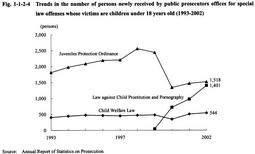| Previous Next Index Image Index Year Selection | |
|
|
2 Trends in special law offenses In this subsection, we will exclude examination of those special law offenses that will be described in later sections, such as traffic offenses ( Section 3 of this Chapter ), drug offenses ( Section 4 of this Chapter ), financial and economic offenses ( Section 5 of this Chapter ), election-related offenses ( Section 6 of this Chapter ), and offenses by foreign nationals ( Chapter 2, Section 2 ), but examine trends in violations of the following 9 laws, for which the number of persons newly received by public prosecutors offices has been relatively large, such as the Minor Offenses Law, Firearms and Swords Control Law, Horse Racing Law/Bicycle Racing Law/Motorboat Racing Law, Adult Entertainment Law, Anti-Prostitution Law, Wastes Disposal Law, and Marine Pollution Prevention Law. Then, we will also examine trends in the offenses of which victims are children under 18 years old as well as violations of the Industrial Safety and Health Law, Labor Standards Law, Law Concerning the Control of Stalking or the Like (Anti-Stalking Law: Law No. 81 of 2000), and Law for the Prevention of Spousal Violence and the Protection of Victims (DV Prevention Law: Law No. 31 of 2001) (see Appendix 1-4 ).
Fig. 1-1-2-3 shows the trends in the number of persons newly received by public prosecutors offices for violations of the Minor Offenses Law, Firearms and Swords Control Law, Wastes Disposal Law, Adult Entertainment Law, Anti-Prostitution Law, Horse Racing Law/Bicycle Racing Law/Motorboat Racing Law, and Marine Pollution Prevention Law, over the last 10 years. This figure indicates that violations have been on a rising trend of the Firearms and Swords Control Law, Wastes Disposal Law, Adult Entertainment Law and Anti-Prostitution Law. Fig. 1-1-2-3 Trends in the number of persons newly received by public prosecutors offices for special law offenses, by type of offense (1993-2002) Fig. 1-1-2-4 shows the trends in the number of persons newly received by public prosecutors offices for violations of the Child Welfare Law, Law against Child Prostitution and Pornography, and the Juveniles Protection Ordinance, over the last 10 years. The number increased from the previous year for these laws/ordinance in 2002.Fig. 1-1-2-4 Trends in the number of persons newly received by public prosecutors offices for special law offenses whose victims are children under 18 years old (1993-2002) Fig. 1-1-2-5 shows the trends in the number of persons newly received by public prosecutors offices for violations of the Industrial Safety and Health Law and Labor Standards Law over the last 10 years.The number of persons newly received by public prosecutors offices for Industrial Safety and Health Law violations has been on a decreasing trend since 1997, whereas the number for Labor Standards Law violations has been on an increasing trend since 1999. Fig. 1-1-2-5 Trends in the number of persons newly received by public prosecutors offices for special law offenses related to labor (1993-2002) The number of persons newly received by public prosecutors offices for violations of the Anti-Stalking Law was 18 in 2000, which increased to 126 in 2001 and 167 in 2002 (Source: Annual Report of Statistics on Prosecution).The number of persons newly received by public prosecutors offices for violations of the DV Prevention Law was 2 in 2001, and increased to 36 in 2002 (Source: Annual Report of Statistics on Prosecution). Explanation of terms, Persons newly received by public prosecutors offices: Persons newly received by public prosecutors offices refers to persons reported to or directly received by public prosecutors and persons referred by judicial police officers (including special judicial police officers and inspectors of the National Tax Agency) to public prosecutors (Source: Annual Report of Statistics on Prosecution). |


